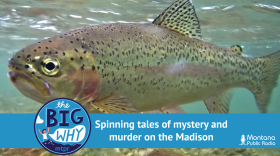Answers to your questions — big or small — about anything under the Big Sky.

The Big Why (get it?) is part of MTPR’s commitment to community-led journalism, telling the diverse stories of Montanans like you.
Join us in this collaborative! Ask your questions about anything under the Big Sky and we’ll help dig up the answers.
No question is too big or too small for the Big Why. Let's see what we can discover together!
Join us in this collaborative! Ask your questions about anything under the Big Sky and we’ll help dig up the answers.
No question is too big or too small for the Big Why. Let's see what we can discover together!
-
If you've ever seen or experienced a pickup pull alongside or in front of you and then belch out a huge cloud of black or gray exhaust — well, you've just been coal-rolled. But why?
-
In 2023 the Blackfeet Nation released bison into the Chief Mountain area along the border of Glacier National Park. The release was part of a plan to build a free roaming herd in a place bison had been absent from for more than 100 years. One listener wants to know where those bison are now.
-
In the '90s, whirling disease hit trout populations hard in Montana, at one point leading to a 95% decline in rainbow trout in the Madison River. It sparked concern among biologists, anger in tourist towns and even played a role in a murder mystery novel. It also inspired this week's question: What's happening with whirling disease and other threats to trout?
Your questions answered
-
Farming and ranching combined generate billions of dollars in revenue and employ tens of thousands of Montanans. They’re also on the cusp of a generational sea change. One listener wants to know how young people are being encouraged and prepared for life as a farmer or rancher.
-
Montana voters approved a constitutional amendment in November to protect access to abortion. What would federal anti-abortion laws mean for Montana's new amendment?
-
You probably know snowpack affects the amount of water in our rivers. But snowmelt also recharges underground water systems and flows back into the rivers and streams, keeping them running even after the snow melts. What happens to groundwater supplies when the snowmelt comes earlier in the year?
-
An archeological find in the Shields Valley in 1968 revealed some surprising new information about the earliest inhabitants the state, and provides a window into the shifting ethics of modern archeology. Our story starts in the Ice Age, when people took to the mountains of Montana to hunt camels, cheetahs and mammoths.




















